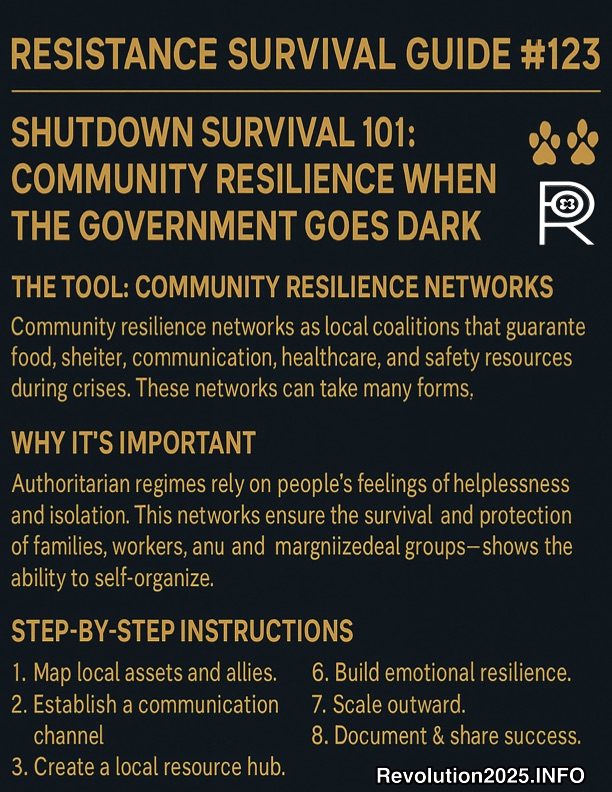Skill Level: 🐾🐾 Intermediate
🧰 The Tool: Community Resilience Networks
When the government stops functioning, communities must. Community resilience networks are local coalitions that coordinate food, shelter, communication, healthcare, and safety resources during crises. They’re mutual-aid systems built by neighbors — decentralized, fast, and powered by trust instead of bureaucracy.
These networks can take many forms: neighborhood groups, encrypted chat channels, pop-up food banks, or shared childcare collectives. Their purpose is simple — to make sure no one gets left behind when authoritarian policies create deliberate instability.
💡 Why It’s Important
Authoritarian regimes depend on people feeling helpless and isolated. A shutdown isn’t just about budgets — it’s about breaking the public’s confidence that democracy can deliver. When communities show they can survive — and even thrive — without federal permission slips, they expose that lie.
Building resilience networks ensures that families have food, workers have backup income, and marginalized groups have protection. The ability to self-organize is both a survival tactic and a political statement: We don’t need your permission to take care of each other.
⚡ Example of Importance
In 2020, when the federal response to COVID-19 collapsed, mutual-aid networks across the U.S. delivered millions of meals, medical supplies, and survival funds long before official agencies mobilized.
In Puerto Rico after Hurricane María, grassroots organizations like Casa Pueblo kept the lights on with solar microgrids and community kitchens while the government failed to act.
In 2025, the same principle applies — whether it’s Trump freezing federal funds to blue states or the shutdown halting paychecks, community networks step in where leadership has walked out.
🪜 Step-by-Step Instructions
1. Map Local Assets and Allies
List every person or group in your area who can contribute — teachers, nurses, tech experts, social workers, organizers. Assign skill categories (food, safety, comms, logistics).
2. Establish a Communication Channel
Pick secure, decentralized tools: Signal, Element, or offline SMS trees. Identify a daily “check-in” time for status updates and needs.
3. Create a Local Resource Hub
Designate a physical or digital hub for donations, requests, and supplies (use libraries, churches, or encrypted spreadsheets). Label drop points clearly and discreetly.
4. Practice Verified Information Sharing
Only circulate information with verifiable sources (journalists, official documents, or court filings). Screenshots and memes can spread disinformation fast — don’t amplify the chaos.
5. Build Emotional Resilience
Organize safe spaces for collective stress relief: potlucks, art nights, or small-group meetups. Burnout is a weapon; community care is armor.
6. Scale Outward
Connect with regional or national networks like Mutual Aid Disaster Relief and ResistanceDirectory.com to trade resources and training materials.
7. Document & Share Success
Record what works — supply chain methods, volunteer rotations, or security protocols — so other groups can replicate your model.

📚 Source List
- ABC News – Shutdown Timeline
- Reuters – $26 Billion Freeze
- Washington Post – Guard Deployment Blocked
- Mutual Aid Disaster Relief
- Mutual Aid Hub
- Resistance Directory

